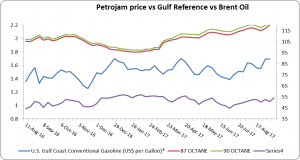Brent Oil
Brent oil prices increased by 6.57%, as prices increased this week. Oil traded on September 6, 2017 at a price of 54.20 (US$/ barrel).
Petrojam prices
87 Octane prices declined week over week, by 2.91% . Additionally 90 Octane declined by 2.85% week over week. 87 Octane and 90 Octane opened the year at J$97.32 and J$98.98 respectively and now trades at J$120.40 and J$123.24 per litre .

Figure 1: Petrojam, U.S. Gulf Coast Conventional Gasoline Regular and Brent Crude Oil 1 Year Price History
This Week in Petroleum
Hurricane Harvey adds uncertainty to gasoline prices for the upcoming Labor Day weekend
Hurricane Harvey, which first made landfall on August 25, 2017, has created considerable uncertainty for gasoline supply and prices, as the area affected by the hurricane is home to much of the nation’s petroleum infrastructure. On August 28, the U.S. average retail gasoline price was $2.40 per gallon (gal), the second-lowest price on the Monday before Labor Day since 2004. However, prices on that date do not yet reflect the full effects of Hurricane Harvey.
Retail gasoline prices vary significantly within the United States as a result of regional supply and demand balances, gasoline specification requirements, and taxes. As of August 28, regular retail gasoline prices were highest in the West Coast region, at $2.90/gal, and lowest in the Gulf Coast region, at $2.16/gal. West Coast retail gasoline prices are often above the national average because of the region’s isolation from additional supply sources, gasoline specifications that are more costly to manufacture, and higher taxes. The U.S. Gulf Coast typically has the lowest retail gasoline prices in the country because it is home to approximately 50% of U.S. petroleum refining capacity. The Gulf Coast also produces more gasoline than it consumes, and regional state taxes on gasoline tend to be relatively low.
However, Hurricane Harvey, which hit the Gulf Coast last Friday, has affected crude oil production and refinery operations in the region. A number of refineries have shut down or are operating at reduced rates, which will likely have implications beyond the Gulf Coast. The East Coast in particular is largely dependent on pipeline shipments of transportation fuels from the Gulf Coast.
The Colonial pipeline, a major pipeline supplying petroleum products from the Gulf Coast to the East Coast, is usually fully utilized but is now operating intermittently because of a lack of refinery and terminal product available to fill the line. Several challenges still remain in quickly restarting refineries, including loss of electricity, the ability of personnel to reach the refineries, and the capacity to gather and distribute crude oil and petroleum products.
https://www.eia.gov/petroleum/weekly/
